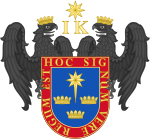Viceroyalty of Peru facts for kids
Quick facts for kids
Viceroyalty of Peru
Virreinato del Perú
|
|||||||||||||||||||||||||
|---|---|---|---|---|---|---|---|---|---|---|---|---|---|---|---|---|---|---|---|---|---|---|---|---|---|
| 1542–1824 | |||||||||||||||||||||||||
|
Motto: Plus Ultra (Latin)
"Further Beyond" |
|||||||||||||||||||||||||
 Flag of Spain: first national flag, naval and fortress flag, the last flag to float in continental America, in the Real Felipe Fortress |
|||||||||||||||||||||||||
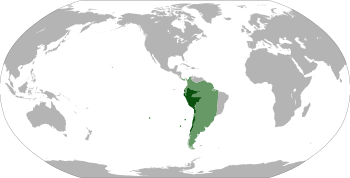
Location of the Viceroyalty of Peru: Initial territory 1542–1718 (light green) and final de jure territory 1776–1824 (dark green)
|
|||||||||||||||||||||||||
| Status | Viceroyalty of the Spanish Empire | ||||||||||||||||||||||||
| Capital | Lima (1535–1821) Cuzco (1821–1824) |
||||||||||||||||||||||||
| Common languages | Spanish (official, administrative) Quechua Kichwa Aymara Puquina Mapudungun |
||||||||||||||||||||||||
| Religion | Roman Catholic | ||||||||||||||||||||||||
| Government | Monarchy | ||||||||||||||||||||||||
| King | |||||||||||||||||||||||||
|
• 1544–46
|
Charles I (first) | ||||||||||||||||||||||||
|
• 1816–24
|
Ferdinand VII (last) | ||||||||||||||||||||||||
| Viceroy | |||||||||||||||||||||||||
|
• 1544–46
|
Blasco Núñez Vela (first) | ||||||||||||||||||||||||
|
• 1821–24
|
José de la Serna e Hinojosa (last) | ||||||||||||||||||||||||
| Historical era | Spanish Empire | ||||||||||||||||||||||||
|
• Established
|
20 November 1542 | ||||||||||||||||||||||||
| May 1572 | |||||||||||||||||||||||||
| 27 May 1717 | |||||||||||||||||||||||||
| 1 August 1776 | |||||||||||||||||||||||||
| 28 July 1821 | |||||||||||||||||||||||||
| 9 December 1824 | |||||||||||||||||||||||||
| Area | |||||||||||||||||||||||||
|
• Total
|
1,340,000 km2 (520,000 sq mi) | ||||||||||||||||||||||||
| Currency | Spanish dollar | ||||||||||||||||||||||||
|
|||||||||||||||||||||||||
The Viceroyalty of Peru (Spanish: Virreinato del Perú) was a huge area in South America controlled by Spain. It was like a large province of the Spanish Empire, created in 1542. It originally included modern-day Peru and much of the Spanish lands in South America. Its capital city was Lima.
For a long time, the Viceroyalty of Peru was one of the two most important Spanish areas in the Americas. Over time, its size and power changed. Other viceroyalties, like New Granada and Río de la Plata, were created from its territory. This made Lima less important for trade.
Eventually, the Viceroyalty of Peru ended in the early 1800s. This happened as countries in South America fought for their independence from Spain. Many modern countries, such as Peru, Chile, Colombia, Panama, Ecuador, Bolivia, Paraguay, Uruguay, and Argentina, were once part of this large Spanish territory.
Contents
History of the Viceroyalty
Spanish Conquest of Peru
After the Spanish conquest of Peru, the Spanish king, Charles V, gave special rights to the conquerors. These rights allowed them to become governors and judges in the lands they took over. Before the Viceroyalty of Peru was officially set up, several large areas were formed. These included the Governorate of New Castile (1529), Governorate of New Toledo (1534), and others.
Early Years and Exploration (1542–1643)
In 1542, Spain decided to organize these areas better. They created the Viceroyalty of New Castile, which soon became known as the Viceroyalty of Peru. This was done to control and govern Spanish South America more effectively.
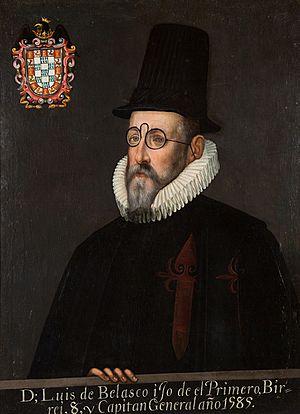
In 1544, King Charles I of Spain named Blasco Núñez Vela as Peru's first viceroy. A viceroy was like a governor who ruled on behalf of the king. Later, Lope García de Castro served as an interim (temporary) viceroy. He set up the first Audiencia (a high court and administrative body) in Spanish South America.
The viceroyalty became truly organized when Viceroy Francisco Álvarez de Toledo arrived. He traveled all over the region to understand it better. Toledo was a very important leader. He created the Inquisition in Peru and made laws for both native people and Spanish settlers. He also changed the old mita system, which was a type of forced labor.
Toledo also made the viceroyalty safer. He built forts and bridges and created a navy called la Armada del Mar del Sur to protect against pirates. He ended the last independent native state, the Neo-Inca State, by executing the Inca leader Túpac Amaru. He also helped the economy grow by focusing on trade and mining, especially silver from the Potosí mines.
Spanish ships explored some Pacific islands in the 1500s, like New Guinea (1545) and the Solomon Islands (1568). However, they did not try to settle or trade with these islands.
The first Jesuit missions were started in 1609 to teach Christianity to native people. However, groups from Brazil, called bandeirantes, moved into parts of the Amazon. These groups often enslaved native people.
In 1617, Viceroy Francisco de Borja y Aragón divided the government of Río de la Plata into two parts: Buenos Aires and Paraguay. Both were under the Viceroyalty of Peru. He also created the Tribunal del Consulado, a court for business matters. Other viceroys, like Fernando Torres, improved the navy and fortified ports to defend against foreign attacks.
The Last Spanish Habsburg Rulers (1643–1713)
Viceroys during this time had to protect the Pacific coast from French smugglers and English and Dutch pirates. They made the navy stronger and built walls around cities like Lima (1686) and Trujillo (1685–1687). Despite these efforts, the famous pirate Henry Morgan attacked and looted Panama City in 1670.
Revolts were common during this period. Around 1656, Pedro Bohórquez claimed to be the Inca emperor of the Calchaquí people, leading them to revolt. There were also major earthquakes (1655, 1687) and diseases.
Viceroy Melchor de Navarra y Rocafull reopened the Lima mint, which made coins, in 1683. Viceroy Diego Ladrón de Guevara increased silver production in the mines of Potosí and other areas. He also controlled the making of aguardiente (a strong alcoholic drink) and taxed it heavily.
New churches and hospitals were built in Lima during this time, showing the growth of the city.
The Bourbon Reforms (1713–1806)
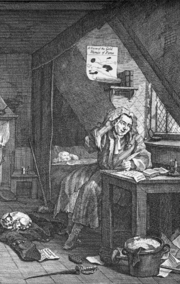
In 1717, the Viceroyalty of New Granada was created from the northern parts of Peru. This new viceroyalty included areas like Bogotá, Quito, and Panamá. It was first temporary but became permanent in 1740. Later, in 1776, the Viceroyalty of the Río de la Plata was created from Peru's southern lands. This included parts of modern-day Argentina, Bolivia, Paraguay, and Uruguay. These changes reduced the size and power of the Viceroyalty of Peru.
-
1534
Portuguese America according to the Treaty of Tordesillas -
1750
Portuguese America according to the Treaty of Madrid (1750)
Several viceroys made important changes during this time. Manuel de Amat y Juniet sent an expedition to Tahiti. Viceroy Teodoro de Croix divided the government into smaller areas called intendencias to make it easier to manage. Francisco Gil de Taboada brought the region of Puno back into the Viceroyalty of Peru.
An earthquake destroyed Lima and Callao in 1746. Viceroy Amat y Juniet built many public works in Lima, including the first bull ring. Manuel de Guirior improved hospitals and started a home for abandoned children.
Wars between Spain and Britain continued. Amat y Juniet built the strong fortress of Real Felipe in Callao in 1774 to defend the coast.
Native Peruvian people continued to rebel against Spanish rule. In the 1700s, there were many uprisings. The most famous were led by Juan Santos Atahualpa in 1742 and Túpac Amaru II in 1780. In 1767, the Jesuits, a religious order, were expelled from the colony.
End of the Viceroyalty (1806–24)
Viceroy José Fernando de Abascal y Sousa improved education and reorganized the army. He also stopped local rebellions. During his time, the Inquisition (a religious court) in Lima was temporarily closed.
When the wars for independence began in 1810, Peru remained a strong center for the Spanish royalists (those loyal to the king). Abascal brought back several provinces, like Córdoba and Quito, into the Viceroyalty of Peru. The Spanish army in Peru fought against independence movements from Argentina and Chile for 14 years. Peru became the last place in South America where the Spanish king still had strong control.
Lord Cochrane, a British naval officer, attacked Guayaquil and Callao. He captured Valdivia in 1820, which was a very important port. However, the viceroyalty managed to defend Chiloé Island until 1826.
On September 8, 1820, an army called the Expedición Libertadora (Liberating Expedition) landed near Pisco. This army was led by José de San Martín and included soldiers from Argentina, Peru, and Chile. After talks with the viceroy failed, San Martín's army took Lima, the capital, on July 21, 1821. Peru declared its independence on July 28, 1821. Viceroy José de la Serna e Hinojosa, still with a large army, moved his forces to Cusco.
In 1822, San Martín and Simón Bolívar met to plan how to free the rest of Peru. After this meeting, San Martín returned to Argentina, and Bolívar prepared to fight the remaining Spanish forces. In 1823, Bolívar arrived in Lima.
In February 1824, the Spanish briefly took back Lima. However, a rebellion started by Pedro Antonio Olañeta (a Spanish royalist) against Viceroy La Serna caused a civil war within the Spanish army. This weakened the royalist forces. Bolívar then led his rebel army south. They met the Spanish army at the Battle of Junín on August 6, 1824. The Peruvians won this battle, which was fought entirely without guns. The Spanish then left Lima for a second time.
The Spanish only controlled Cuzco and the surrounding highlands. The viceroy launched a counter-attack near Ayacucho. This is where the final battle for Peru's independence took place.
On December 9, 1824, the Battle of Ayacucho happened. This battle, between the Spanish royalist army and the nationalist (republican) troops, secured the independence of Peru and South America. Antonio José de Sucre, Bolívar's main commander, led the winning nationalist forces. Viceroy Serna was injured and captured. After the battle, Serna signed an agreement for the Spanish to leave Peru.
Spain tried to hold onto its former lands, but after King Ferdinand VII of Spain died, Spain officially gave up its claims to all of mainland America in 1836. In 1879, Spain signed a treaty recognizing Peru's independence.
Government and Society
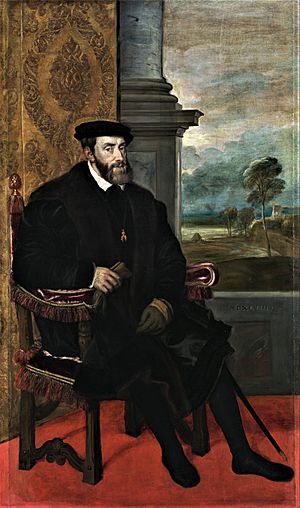
Lima, founded by Pizarro in 1535, became the capital of the new viceroyalty. As the main city for the viceroy, who oversaw almost all of Spanish South America, Lima grew very powerful. For over 200 years, all the wealth from South American silver mines passed through Lima on its way to Spain. This made Lima a rich and important city, with a famous university, the Royal and Pontifical University of San Marcos.
At first, Spanish settlers called encomenderos relied on local native leaders (curacas) to get labor from the native population. Over time, the Spanish government took more control. The encomienda system was replaced by the repartimiento system, also known as mita in Peru. This system was controlled by royal officials.
The viceroyalty was divided into smaller areas called audiencias. These were mainly high courts, but they also helped with administration and making laws. Each audiencia reported to the Viceroy of Peru for administrative matters. These areas were further divided into "governorates" (gobernaciones), led by a governor. Areas facing military threats were grouped into "captaincies general," like the Captaincy General of Chile. These had both military and political leaders and some independence.
At the local level, there were hundreds of districts. These were led by a corregidor (like a mayor) or a cabildo (town council). In the late 1700s, the Spanish king introduced intendants, who had broad financial powers. This reduced the power of the viceroys and other local leaders.
Audiencias (High Courts)
These were important courts and administrative bodies.
- Panamá (1538–43, then 1564–1751)
- Santa Fe de Bogotá (1548)
- Quito (1563)
- Lima (1543)
- La Plata de los Charcas (1559)
- Chile (1563–73; 1606)
- Buenos Aires (1661–72; 1776)
- Cuzco (1787)
Some of these later became part of the Viceroyalty of New Granada or the Viceroyalty of the Río de la Plata.
Autonomous Captaincy General
- Chile (1789)
Intendancies (Administrative Divisions)
These were created to improve local administration:
- 1783: Lima, Puno
- 1784: Trujillo, Tarma, Huancavelica, Cusco, Arequipa
- 1786: Santiago, Concepción
Economy and Wealth
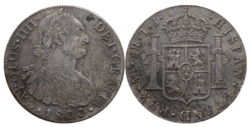
The economy of the Viceroyalty of Peru was mostly based on exporting silver. Huge amounts of silver from Peru and Mexico went to Europe. Some historians believe this caused a "price revolution" there, meaning prices went up a lot. Silver was mined using both paid workers and the mita system, which was a form of forced labor from Inca times. Silver production was highest around 1610.
When the Viceroyalty of Peru was set up, gold and silver from the Andes mountains made the Spanish conquerors very rich. Peru became the main source of Spain's wealth and power in South America. The first coins for Peru were made between 1568 and 1570. Even today, Peru and Bolivia produce a lot of the world's silver.
Most of the silver went to Europe, but some stayed in South America. For example, the Real Situado was a yearly payment of silver from Peru. This money was used to pay the Spanish army in Chile, which was fighting a long war called the Arauco War. The Spanish sometimes traded this silver with the Mapuches, leading to their famous Mapuche silverwork.
Another cost for the viceroyalty was maintaining the Valdivian Fort System. These forts were built to protect against attacks, like the one by the Dutch in 1643.
Viceroy Luis Jerónimo Fernández de Cabrera stopped direct trade between Peru and New Spain (Mexico). He also took action against Portuguese Jews, who were important traders in Lima.
People and Population
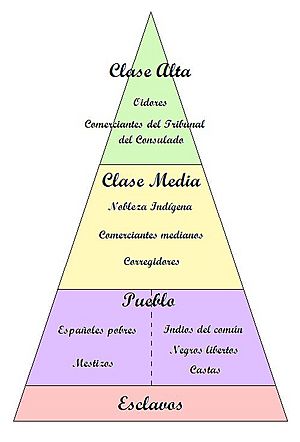
A census taken by the last Inca record-keepers (Quipucamayoc) showed that Inca Peru had 12 million people. However, 45 years later, under Viceroy Toledo, the count was only 1.1 million native people. This huge drop was not a planned attack, but mostly happened because of diseases like smallpox from Europe. Native people had no protection against these illnesses.
Inca cities were given Spanish Christian names and rebuilt as Spanish towns. Each town had a central square (plaza) with a church and official buildings. Some Inca cities, like Cuzco, kept their original stone foundations. Other Inca sites were abandoned for new cities in lower areas that were more comfortable for the Spanish.
Viceroy José de Armendáriz brought back a system where Inca nobles could prove their family history. If they could, they were recognized as hijosdalgos of Castile, which was a type of Spanish nobility. This made many native nobles eager to prove their status.
In the 1790s, Viceroy Francisco Gil de Taboada ordered the first official count of the population. The last shipment of enslaved Black people arrived in Peru in 1806. At that time, an adult male slave was sold for about 600 pesos.
Culture and Learning
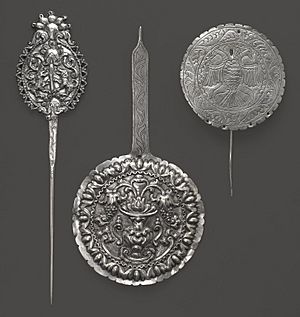
Viceroy Francisco de Borja y Aragón reorganized the University of San Marcos. Other viceroys, like Luis Jerónimo Fernández de Cabrera and Diego Ladrón de Guevara, added new subjects like medicine and anatomy to the university. In 1810, the San Fernando medical school was founded.
Viceroy Melchor Liñán y Cisneros made mathematics a permanent subject at the University of San Marcos. He appointed a Belgian scientist, Doctor Juan Ramón Koening, to teach it.
Luis Enríquez de Guzmán, 9th Count of Alba de Liste founded the Naval Academy in the colony. Viceroy Francisco Gil de Taboada also supported a navigation school. Teodoro de Croix started the Botanic Garden of Lima.
Francisco de Borja y Aragón also founded schools in Cuzco: the Colegio del Príncipe for sons of native nobility and the Colegio de San Francisco for sons of Spanish conquerors. Manuel de Amat y Juniet founded the Royal College of San Carlos.
The first books in Peru were printed by Antonio Ricardo, who came from Italy and settled in Lima. Diego de Benavides y de la Cueva built the first theater in Lima. Viceroy Manuel de Oms y de Santa Pau started a literary academy in 1709. This academy held weekly discussions that attracted famous writers from Lima. He also brought French and Italian styles to the viceroyalty. The Italian musician Rocco Cerruti came to Peru during this time. Francisco Gil de Taboada helped start the newspaper El Mercurio Peruano in 1791 and founded the Academy of Fine Arts.
Jesuit Barnabé de Cobo (1582–1657), who explored Mexico and Peru, brought cinchona bark (used for medicine) from Lima to Spain in 1632.
In 1671, Rose of Lima became the first person born in the Americas to be recognized as a Catholic saint. Later, two other important Peruvian saints, Toribio Alfonso de Mogrovejo and Francisco de Solano, were also recognized.
Diego Quispe Tito was a famous artist in Peru before the country gained independence.
Science and Discovery
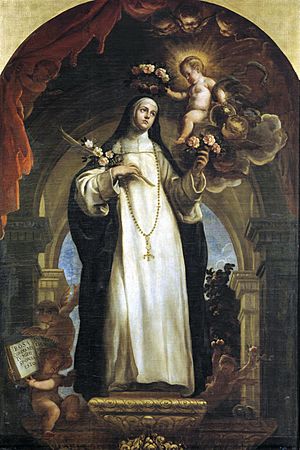
In 1737, Jorge Juan y Santacilia and Antonio de Ulloa, Spanish scientists, arrived in Peru. They were sent on a scientific mission by the French Academy to measure the Earth at the equator. They also had a secret task to report on problems in the government and smuggling. Their report was later published as Noticias Secretas de América (Secret News From America).
Viceroy Manuel de Guirior supported a scientific expedition led by Hipólito Ruiz López, José Antonio Pavón, and Joseph Dombey. This group studied the plants of the viceroyalty from 1777 to 1788. Their discoveries were later published as La flora peruana y chilena (The Flora of Peru and Chile). This expedition also aimed to boost the economy by improving agriculture, mining, trade, and industry.
Another French scientist, Louis Godin, who was part of the equator measurement expedition, became the cosmógrafo mayor (chief cosmographer) in Peru. His job included publishing almanacs and sailing instructions. Charles Marie de La Condamine, another French scientist, also visited Peru during this time.
The Balmis Expedition, which brought smallpox vaccine, arrived in Lima on May 23, 1806. At the same time, viceroys tried to stop the spread of revolutionary ideas from the United States and France.
|
See also
 In Spanish: Virreinato del Perú para niños
In Spanish: Virreinato del Perú para niños


